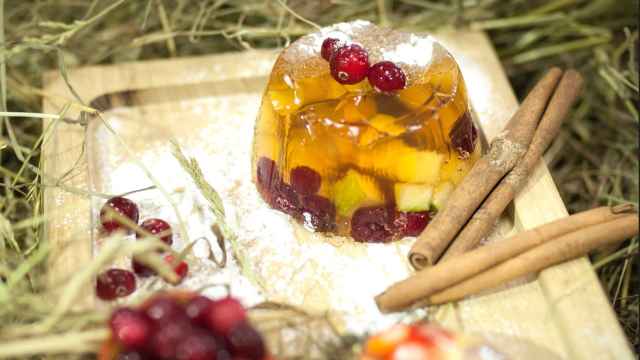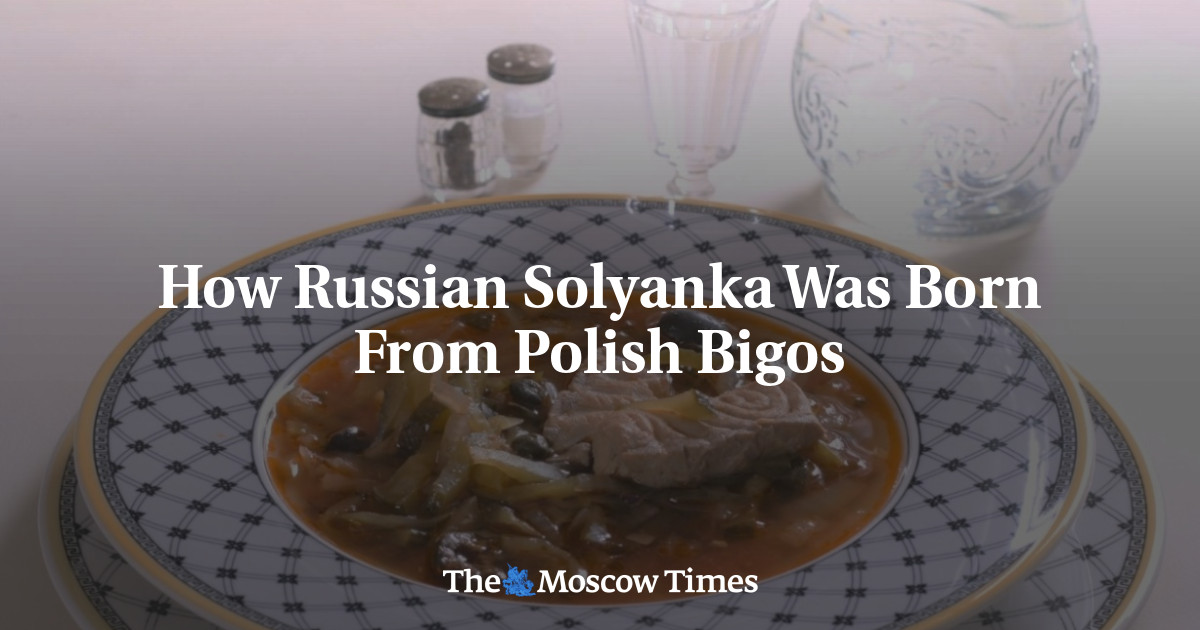
Now is the time to support independent reporting from Russia!
How Russian Solyanka Was Born From Polish Bigos
… and then turned into a soup.
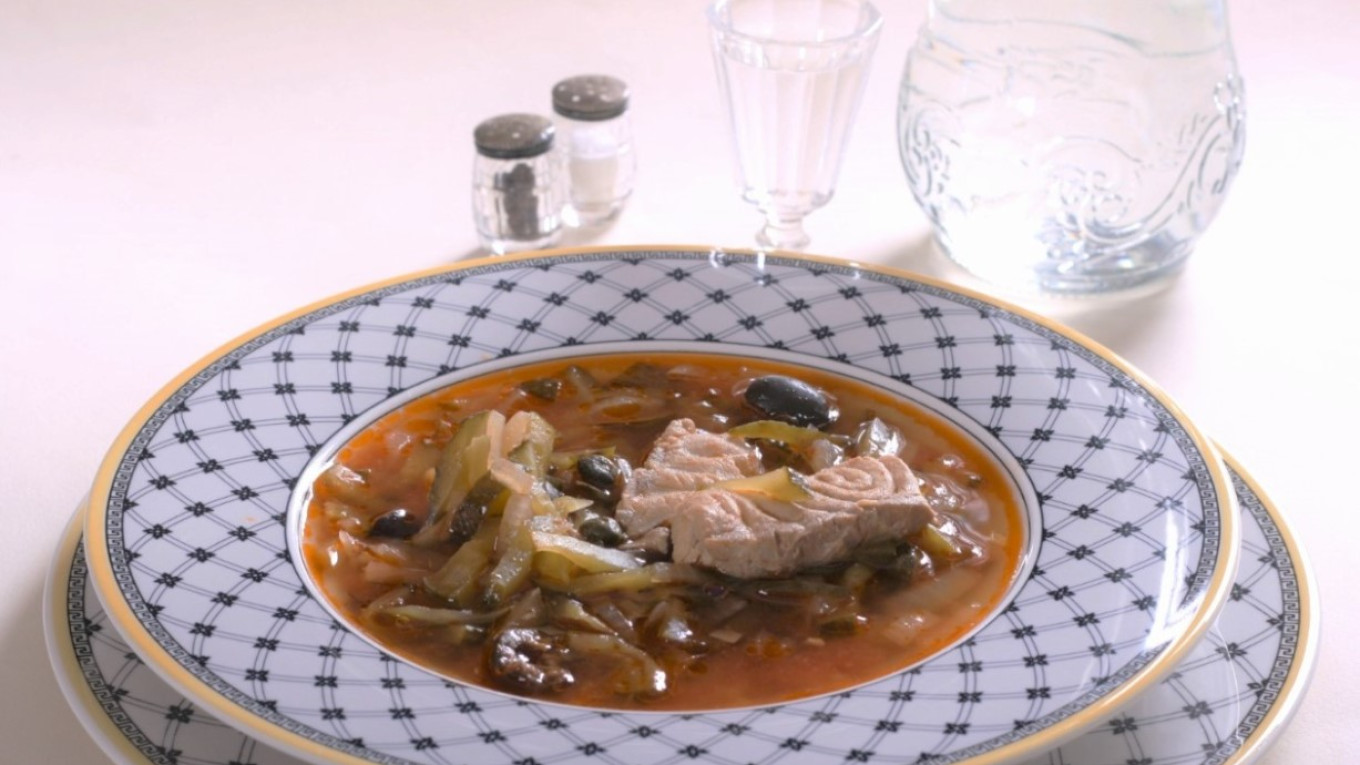
Solyanka is one of Russian dishes that has a very convoluted and confusing history. Is it a soup or a main course of stewed cabbage? Is it spelled “solyanka” or “selyanka?” And while we’re asking questions, when did it appear in Russia?
This dish is like a magnet that attracts every kind of guess and speculation. In Russia there is eternal confusion over the two versions of the name —”solyanka” and “selyanka.” The latter word also means “villager.” This gave rise to wild origin stories about how fat villagers made this soup with meat and sour cream while thin city ladies preferred it with sturgeon.
But the name is not the main controversy. “I ate a lot of Polish cuisine, one of the heaviest in the world with so much fat and sour cream,” noted the Russian writer and publicist Konstantin Skalkovsky (1843-1906) in his memoirs. “I even discovered the charm of ‘bigus’ — the Moscow dish of selyanka in a frying pan is like a parody of the original. Poles assure us that it was amazingly good in the 17th century, when they stuffed feedbags on saddles with bigus, and the noblemen heated it up throughout a campaign. The longer you cook sauerkraut, the better it tastes.”
Actually, Skalkovsky’s joke that Moscow solyanka is a parody of bigus is not too far from the truth. After all, when was the first mention of solyanka/selyanka in Russia? The first written source dates to the 17th century. At that time, it wasn’t a soup. It was a hot dish of cabbage, salted cucumbers, meat, poultry, fish, mushrooms or other products. Its main characteristic is the sour taste from brine or sometimes even from vinegar. In fact, the notion that Moscow solyanka appeared only after Stanislav Zholkevsky’s Polish troops captured Moscow in 1610 is not so far-fetched. However, it’s unlikely that the adoption of the foreign dish took place overnight — it is a longer process.
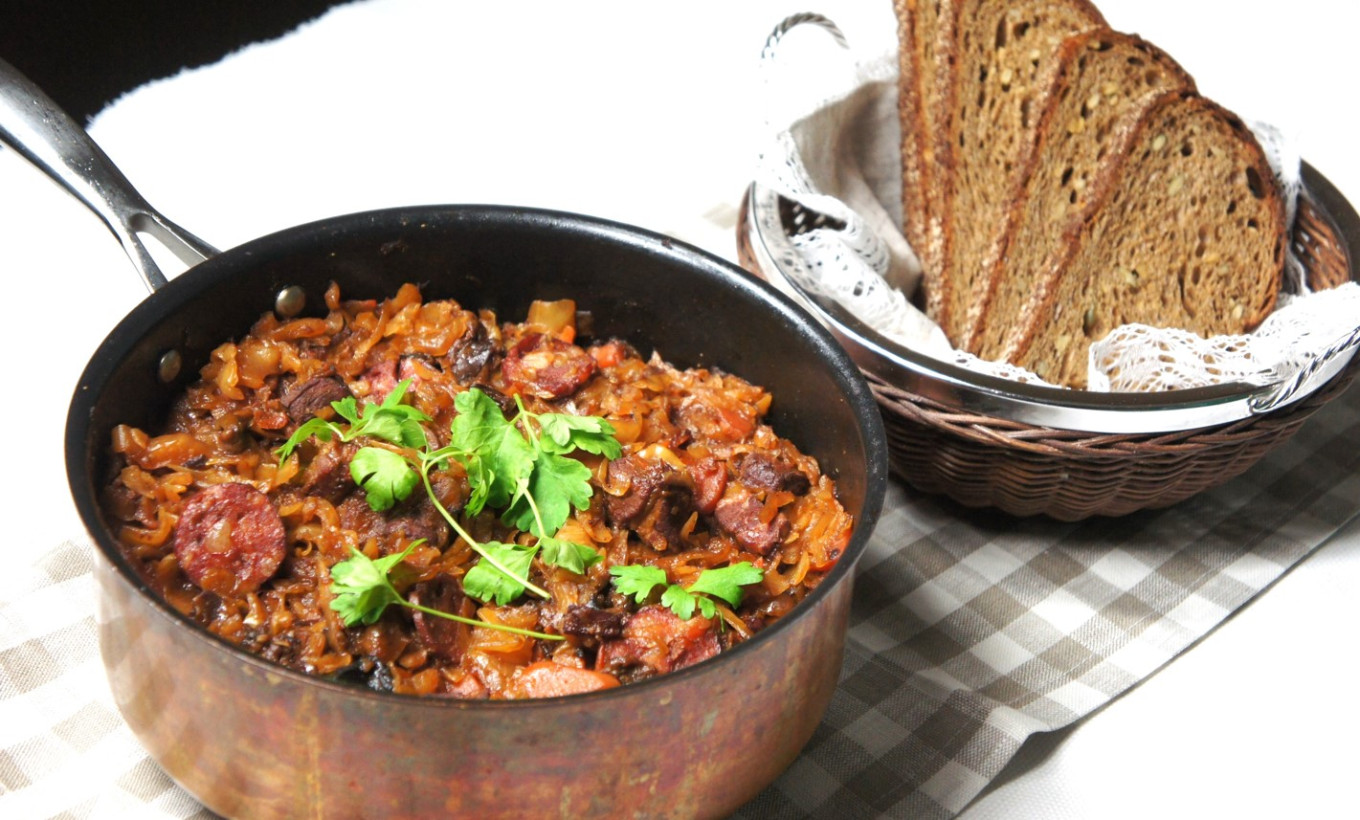
There is very contradictory information about this dish in the academic literature about Russian cuisine. For example, William Pokhlebkin reports that “in the 17th century all the main types of Russian soups were established, and at this time some salty and spicy soups like kaliya, pokhmelka, and solyanka that were unknown in the medieval period appeared.” In another book he writes that solyanka was first mentioned in the 16th century: “The old term solyanka is recorded in the 1547 book ‘Domostroi,’ where solyanka is almost the same as pokhmelka.”
Unfortunately, this is a mistake. There is no mention of solyanka in the “Domostroi.” Nor can it be found in the later “List of the Tsar’s Dishes” (1610-1613). There is mention of brine (“rossol”) and brined dishes. But that’s like saying that solyanka was first mentioned on 13th-century birch bark in Novgorod because someone wrote the word “salt.”
One of the first recipes for selyanka in Russian culinary literature was given by Nikolai Osipov in his book “Ancient Russian Housewives, Housekeepers and Troublemakers” (1794):
SELYANKA
Take sauerkraut, finely chopped onions, butter, vinegar, pepper, and slices of ham, put it all in a skillet and fry it thoroughly. Many also add finely chopped pickled cucumbers and onion slices.
And even almost 30 years later, in the “Dictionary of the Russian Academy,” (1822) solyanka is still not a first course, but a main dish. Solyanka, the dictionary notes, “is a dish seasoned with sauerkraut, fish and beef, ham, vinegar and pepper.”
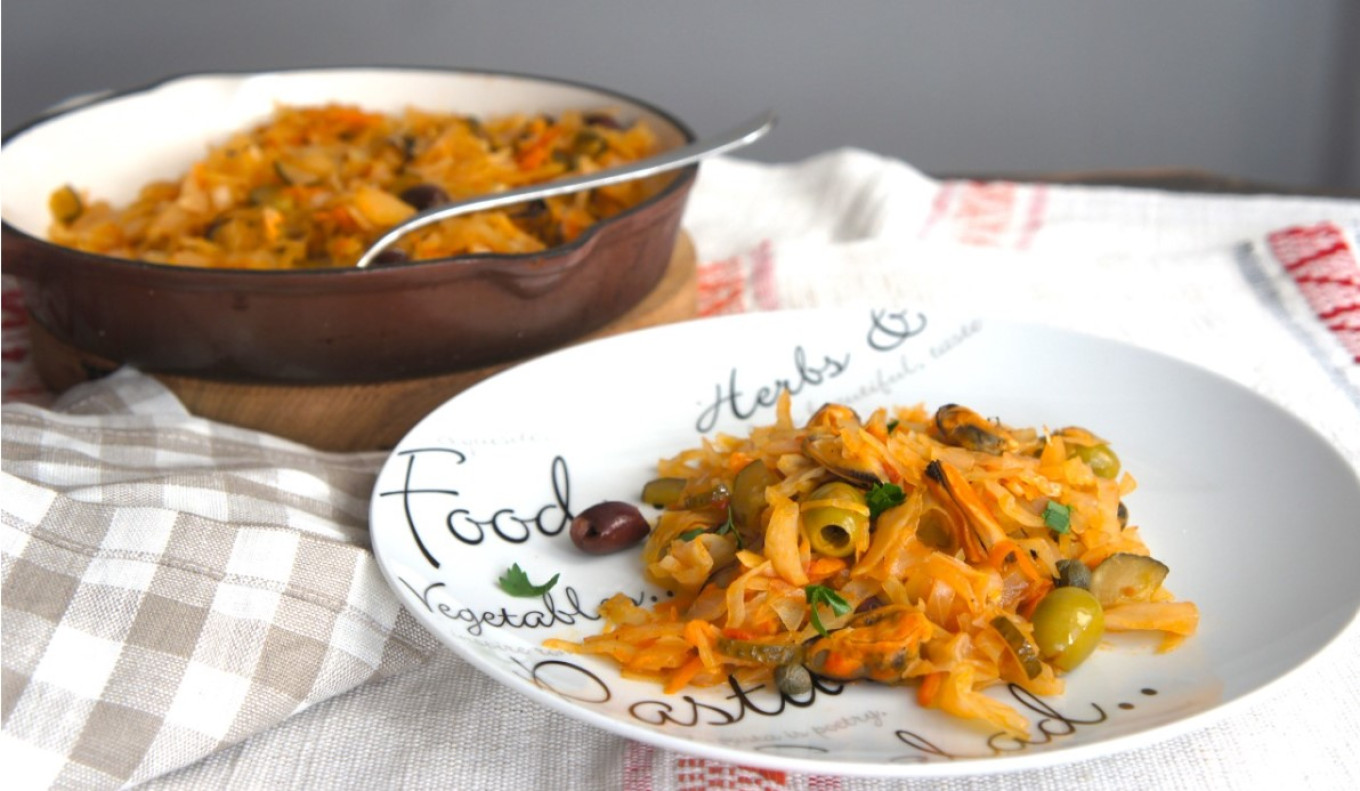
But solyanka as a soup dates back to the 1830s. Russian chef Gerasim Stepanov in 1834 writes about this dish in his section on “Miscellaneous Shti” (shchi), including it along with soups made from nettles and Ukrainian borshch.
SELYANKA WITH HERRING
Chop ham, pound breadcrumbs, chop beef, onions and pickled cucumbers. Add sauerkraut to the pot and fry it in butter. Then pour in good broth, add herring, make it sour and sprinkle with chopped dill. When it is done add sour cream and the selyanka is ready.
Since the 1840s, solyanka soup has increasingly been mentioned as an independent dish. “The Handbook of an Experienced Russian Hostess” (1842) by Yekaterina Avdeyeva has a version of solyanka soup made with mushrooms:
Solyanka with saffron milk cap. When making a broth of beef, take saffron milk cap mushrooms, or other milk caps, wash them, slice or chop them, add one onion and put in the broth. When it is well boiled, season with flour and butter.
In the second half of the 19th century, solyanka becomes the dish we know today. Even Dal notes in his famous dictionary that solyanka is “the common name for all kinds of soups in Russian cuisine: schi, borsch, selyanka, and soups.”
However, there is still some confusion with the variants of spelling “solyanka” and “selyanka.” It is commonly believed that selyanka is fried cabbage with meat and solyanka is soup. But as can be seen from the above recipes, there was no clear distinction in the definition of these dishes in practice.
Later all manner of intricate, fancy versions appeared — it was made with sturgeon, capers, lemon, and smoked meat. Each tavern-keeper showed his talent with his solyanka, attracting customers with unimaginable tastes and smells. Why not, when there was no “classic” recipe for this soup?
It is enough to compare the early recipes for this dish with examples from the late 19th century to understand that solyanka/selyanka is a vivid manifestation of chef’s creativity, evidence of the development of our cuisine from the Middle Ages to the elegant and colorful dishes that made Russian cooking famous.
Solyanka with sturgeon
Ingredients
- 1.5 kg sturgeon (about 3.3 lb) for 3.5-4 liters (quarts) of water
- 1/2 kg (generous 1 lb) salted pickles
- 1 small (about 3.5 oz) bottle of capers (the smaller the capers, the better)
- 4 onions
- 2 medium carrots
- 1/2 c tomato paste
- 1/2 can pitted green olives
- 1/2 can pitted black olives
- 1/2 lemon
- 2 Tbsp olive oil
- Salt, pepper, bay leaf to taste.
Instructions
- If you bought frozen sturgeon, thaw it completely. First in the evening move it from the freezer to the refrigerator where it will defrost gradually, and then take it out of the refrigerator to completely thaw.
- Clean the skin side of the fish with a brush, peel off the skin, fins and horns. If the piece of fish includes the tail, cut it off but don’t throw it away. Wash well everything you’ve removed and put it all in a big soup pot. Cover with cold water and put it on high heat. When it begins to boil and a lot of foam rises to the surface, carefully skim it off. Then put one onion and one carrot into the broth, bring to a boil, turn down the heat and simmer on low for 40 minutes.
- In the meantime, prepare the rest of the ingredients. Peel and julienne the remaining carrots and onions, as well as the pickles. Place in hot oil in a deep saucepan, lightly fry the onion and carrots, add pickles, tomato paste, a little broth from the pot (half to one ladle), cover and stew for 20-25 minutes.
- Take the broth off the fire, strain it through a fine strainer and return it to the pot. Cut the rest of the sturgeon into portions and put it into the broth. When it comes to a boil, remove any foam that rises to the surface. Boil for about 20 minutes, then salt it a bit — but not much since the salted pickles are about to be added. As it cooks, slice the olives into circles.
- And then everything is simple: pour everything in the saucepan into the soup pan, bring to a boil and simmer for about 7 minutes. Then add the green and black olives, the capers straight from the jar with brine and all. Heat it all through for about 5 minutes at a low boil. Turn off the heat, cut the lemons into discs and put them in the soup. Season with dill and parsley.
- That’s it! Take the soup off the heat and let it stand for about 15 minutes before serving.
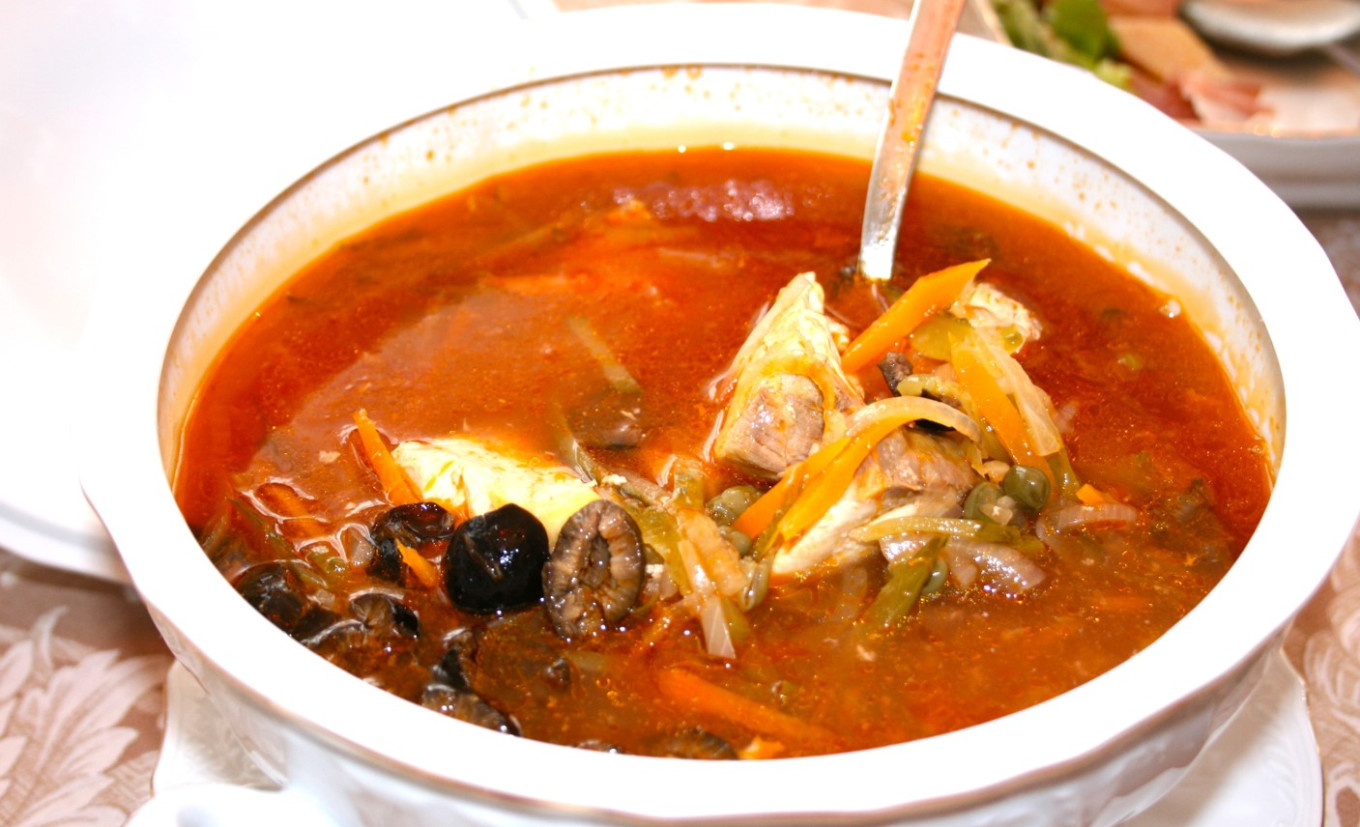
Read more






